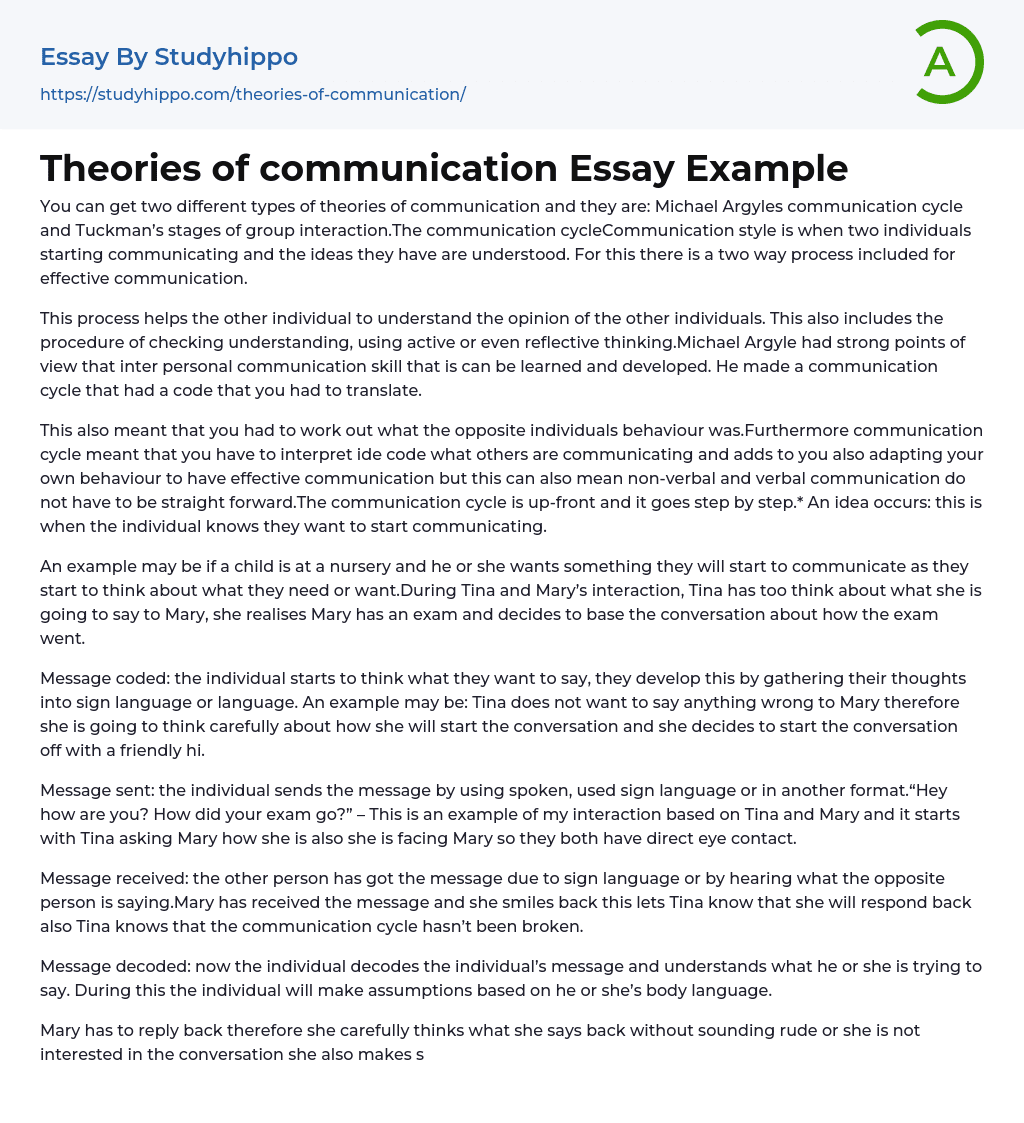There are two different types of theories of communication: Michael Argyle's communication cycle and Tuckman's stages of group interaction. The communication cycle involves a two-way process to ensure effective communication and understanding of ideas between two individuals. This process facilitates the understanding of each other's opinions.
The text stresses the significance of acquiring and enhancing interpersonal communication skills. Michael Argyle asserts that this entails comprehending and deciphering communication codes, as well as adjusting one's conduct for effective communication. Furthermore, the text underscores that communication can be both verbal and non-verbal, often lacking simplicity. The communication cycle is explained as a sequential process beginning with an individual formulating an idea and subsequently encoding their message through sign language or language. Tina aims to avoid making any inappropriate remarks
...towards Mary; therefore, she intends to meticulously select her words. She opts to initiate the conversation with a warm "hi."
The message is sent by the individual using spoken language, sign language, or another format. For example, Tina asks Mary how she is doing and asks about her exam. Tina faces Mary and they have direct eye contact.
The message is received by the other person through sign language or by hearing what the person is saying. Mary receives the message and smiles back, indicating to Tina that she will respond. Tina understands that the communication cycle has not been broken.
The message is decoded by the individual who understands what the person is trying to say. During this process, assumptions may be made based on the person's body language.
Mary carefully considers her response in order to avoid sounding rude or uninterested. She also ensures her facial expressions encourage conversation. In orde
for the message to be understood, the individual must reply back, indicating comprehension. However, this does not necessarily have to occur immediately. Tina and Mary's conversation lacked communication barriers as they both understood each other and provided responses without repetition. When communicating in a group, challenges may arise, such as individuals speaking over one another. The dynamics of group communication are influenced by the sense of belonging among its members. Tuckman's stages of group interaction describe the process of group formation when individuals come together in groups.
People in groups often struggle to communicate effectively until they have undergone a specific process known as group formation. This process consists of four steps: forming, storming, norming, and performing. The first step, forming, occurs when individuals initially meet and begin sharing information with one another.
The text describes a scenario where an individual with a smoking addiction attends a group session. The group session involves five individuals discussing their personal experiences with smoking. The process of the group session can be divided into four stages. The first stage is forming, where the group members get acquainted with each other. The second stage is storming, which involves tension, struggle, and at times arguments regarding the functioning of the group. The third stage is norming, where the group starts to come together and individuals begin to consciously and unconsciously approve of the group's values. The final stage is performing.
After establishing their common expectations and values, the group progresses to the performing stage where they become an effective group. During my work experience, I supervised children in marble painting. In the forming stage of my group conversation, I met three children for
the first time and had limited time to get to know them. I greeted them and introduced the activity, but one child immediately expressed dislike for marble painting and revealed a aversion to getting their hands dirty. This made me concerned about the success of the activity as I still had two more children to engage with.
With this child's aversion in mind, I anticipated difficulties during the storming stage. However, over time, the child started to participate more, which facilitated better communication. They began asking questions such as if they could show the marble to their mom. As a result, the children started working together as a cohesive group.
Despite initial challenges, the performing stage was ultimately successful. The children became engrossed in the activity and were eager to ask about different colors or have me paint their marbles for them. As a result, we functioned as an effective performing group with no communication barriers.
- Arranged Marriage essays
- Communication essays
- Conflict Management essays
- Conflict Resolution essays
- Connection essays
- Conversation essays
- Dating essays
- Friendship essays
- Mediation essays
- Communication Skills essays
- Cross-Cultural Communication essays
- Effective Communication essays
- Greeting essays
- Intercultural Communication essays
- Interpersonal Communication essays
- Nonverbal Communication essays
- Orality essays
- Abnormal Psychology essays
- Abraham Maslow essays
- Attachment Theory essays
- Authority essays
- Behaviorism essays
- Classical Conditioning essays
- Cognitive Psychology essays
- Counseling essays
- Developmental Psychology essays
- Educational Psychology essays
- Erik Erikson essays
- Family Therapy essays
- Jean Piaget essays
- Maslow's Hierarchy Of Needs essays
- Mental Health essays
- Operant Conditioning essays
- Personality Psychology essays
- Positive Psychology essays
- Psychoanalysis essays
- Psychotherapy essays
- Sigmund Freud essays
- Social Psychology essays
- Stanford Prison Experiment essays
- Supersize Me essays
- Experiment essays
- Explorer essays
- Hypothesis essays
- Observation essays
- Qualitative Research essays
- Research Methods essays
- Theory essays




